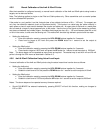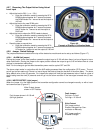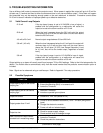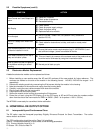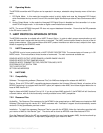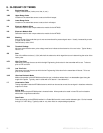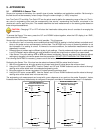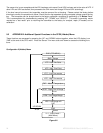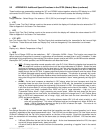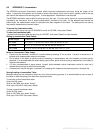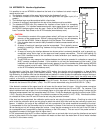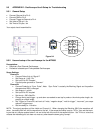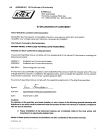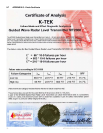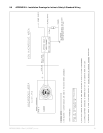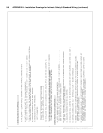
MT2000-0200-1 Rev f (10-2007)
DCN0160 25
9.2 APPENDIX B: Additional Special Functions in the CFG2 (Hidden) Menu (continued)
These functions are accessed by pressing the ‘UP’ and ‘DOWN’ buttons together, when the LCD display is on ‘END’
at the end of the CFG menu. Enter the Sensor Trim menu and scroll down to access the following functions:
• RNG
Range Selection - Select Range 1 for sensors < 100 ft. (30.5 m) and range 2 for sensors ≥ 100 ft. (30.5 m).
• LTP
Sensor "Lower Trim Point" defines a point on the sensor at which the display will indicate the value entered for LTP.
Refer to Appendix A for Sensor Trim instructions.
• HTP
Sensor “High Trim Point" defines a point on the sensor at which the display will indicate the value entered for HTP.
Refer to Appendix A for Sensor Trim instructions.
• LTC / HTC
Low Trim Counts; High Trim Counts: The Raw Counts that are determined by the transmitter for the Low and High
Trim Points. These values are shown as “Display Only” and are changed only if the transmitter is re-trimmed.
• TMP
Display only - Module Temperature in Deg. C
• SOR
Signal Out of Range: SOR has two selections – SAT = Saturation; ALRM = Alarm. This function can prevent the
abrupt output mA change that is common in applications of low dielectric constant fluids in an EC chambers. To take
advantage of this programming, the module’s Failure Alarm jumper must be set HIGH, and ALRM must be selected.
Description: SAT (normal operation) and ALRM selections are described below.
• SAT
– (Existing transmitter normal operation with a low D.C. fluid): When the chamber level exceeds the
URV, the output will continue to track the level until the output saturates at 20.56mA. Should the level
continue to increase to the point that the level echo is lost, the next echo that the module immediately
recognizes is the centering disc at the end of the antenna. Since the centering disc echo is being de-
tected through the low DC fluid, it appears significantly below the actual distance and the output drives
to 3.86mA (saturated output) causing significant control problems. This situation is generally not a prob-
lem with a high DC fluid application because when the transmitter loses its echo, it cannot “see” the cen-
tering disc through the fluid and therefore enters the transmitter’s “alarm” mode (generally set High @ 21
mA).
• ALRM – As the level increases as described in SAT above, when the level increases such that the
transmitter loses the echo from the real level (output is 20.56 mA), the transmitter is prevented from
“seeing” the centering disc below the engineering units entered in LRM. If the transmitter sees no echo,
it will enter its alarm state (21 mA) as programmed by the jumpers on the face of the module. The trans-
mitter’s output now simply increases from 20.56 mA (out of range saturation – high) to 21 mA
(Transmitter Failure Alarm – High), preventing any control upset. When the level drops and the trans-
mitter re-acquires the true level echo, the transmitter’s output will change from 21 mA (Failure Alarm
high) to 20.56 mA (measurement out of range –high), and then track the level downward to 20 mA
(URV) and normal operation.
• LRM – Low Range Margin – the limiting distance below LRV (4.0 mA value) at which a valid
echo will be recognized. This value is displayed and can be changed only when ALRM is se-
lected. LRM is a positive value and can be up to 50% of sensor trim span. This value is not
critical and is typically set at 4.0” (10cm).
• LRS
Low Range Saturation is the lowest current output that the transmitter can attain in normal operation (not in alarm
condition), regardless of the actual measurement value. The LRS limit has no effect on the “Fail Low” alarm current
(3.60mA if selected) with the Fail Hi/Lo jumper position on the face of the module. Should the transmitter lose its
echo, the transmitter will immediately enter its low alarm state (no damping effect) of 3.60mA. LRS has two selec-
tions:
• 3.85 sets 3.85mA as the low limit for the mA signal. As the level decreases below the LRV, the output
current will change proportionally, down to the limit.
• 4.0 sets 4.0mA as the low current limit from the transmitter, preventing a “negative” level in the control
system.



